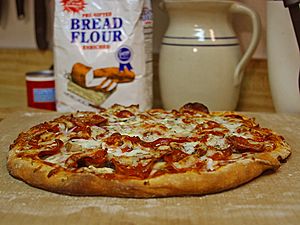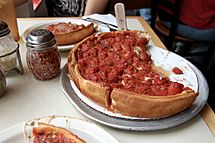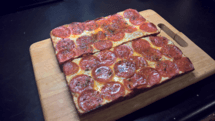Pizza in the United States facts for kids

Pizza in the United States is a super popular dish! It's a bit different from the original pizza found in Italy. After World War II, many American soldiers came back from Italy and brought their love for pizza with them.
Over time, pizza became a huge deal in the U.S. Some people even call it za for short! You can find pizza with thick or thin crusts, depending on what you like. Sometimes, people get creative and use toppings like barbecued chicken or bacon cheeseburger ingredients to make new kinds of pizza.
Pizza is a favorite fast food item. The pizza business in the U.S. is worth billions of dollars! People usually eat pizza hot for lunch or dinner. But it's also common to eat cold leftovers for breakfast sometimes.
Contents
History of American Pizza
The very first pizza place in the U.S. opened in New York City's Little Italy way back in 1905. Over the years, many different toppings became popular in America. These include anchovies, ground beef, chicken, ham, mushrooms, olives, onions, peppers, pepperoni, pineapple, salami, sausage, spinach, steak, and tomatoes.
During the 1900s, special kinds of pizza developed in different U.S. cities. Some famous styles come from Buffalo, California, Chicago, Detroit, Greek, New Haven, New York, and St. Louis. These regional pizzas can be deep-dish, stuffed, or even rolled up! There are endless ways to combine sauces and toppings.
About 13% of people in the U.S. eat pizza every single day! Big pizza chains like Domino's Pizza, Pizza Hut, and Papa John's make it easy to find pizza everywhere. You can also buy pizzas from places where you take them home to bake, or get frozen pizzas from supermarkets.
Pizza Ingredients
American pizza dough often has vegetable oil or shortening mixed in. This isn't as common in Italian pizza recipes. The amount of oil can be small, like in New York style dough, or a lot, like in some Chicago-style deep-dish dough. Also, American pizza often uses flour with a lot of gluten. This type of flour helps the dough stretch very thin without tearing, like strudel or phyllo dough.
Sometimes, pizza doesn't have tomato sauce at all! This is called white pizza. Instead, it might use garlic butter or sauces made with spinach or onions.
Popular Pizza Cheeses
- Mozzarella is the most common cheese used on pizza. Most pizzerias use a type that doesn't have much moisture.
- Provolone is the second most popular. Some places mix it with mozzarella, and a few even use only provolone.
- Cheddar is also popular, often mixed with mozzarella to keep the pizza chewy.
- Parmesan is a hard, aged cheese. In the U.S., pizzerias usually use a generic version, not the special Italian Parmigiano-Reggiano. It's often sold already grated and has a sharp taste.
- Romano is another hard, aged cheese. The Italian version is made from sheep's milk, but U.S. versions are usually made from cow's milk to taste similar.
- Ricotta is used on white pizzas and inside calzones. On white pizza, it can replace tomato sauce. It's often covered with another cheese that melts better.
Different Kinds of American Pizza
- Altoona-style pizza is a special pizza from Altoona, Pennsylvania. It has a thick, Sicilian-style crust, tomato sauce, sliced green bell peppers, salami, and is topped with american cheese. It's cut into squares, not wedges.
- Bar pizza is also called tavern pizza. It has a very thin, crispy crust, almost like a cracker. It's cooked in a shallow pan, which makes the crust a bit oily. The cheese covers the whole pizza, even the edges, making them super crispy. Bar pizzas are usually small (about 10 inches) and served in bars or pubs. They are popular in the Boston area and the Midwest.
- California-style pizza uses unusual ingredients, especially fresh fruits and vegetables. You might find Thai-inspired chicken pizza with peanut sauce, bean sprouts, and carrots, or even taco pizzas and pizzas with chicken and barbecue sauce.
- Chicago-style pizza is known for its thick, moist crust that goes up the sides of a deep pan. The sauce is added last, on top of the cheese and other toppings. Some versions are "stuffed" with two layers of crust and sauce on top.
- Detroit-style pizza is a square pizza, similar to Sicilian style. It has a thick, crispy deep-dish crust with toppings like pepperoni and olives. The marinara sauce is usually on top. Its square shape comes from using metal trays that were originally for small parts in factories.
- Grandma pizza is a thin, square pizza, usually with cheese and tomatoes. It's like the pizzas Italian grandmas used to make at home without a special pizza oven. It became popular on Long Island.
- Greek pizza is popular in New England. It's named after the Greek immigrants who often owned the pizzerias. It has a thicker, chewier crust and is baked in a pan, not directly on oven bricks. Olive oil is often used on the toppings and to grease the pans for a crispy crust. Other Greek pizzas might use feta cheese, Kalamata olives, and Greek herbs like oregano.
- Grilled pizza is made by putting a thin pizza dough directly on a grill fire. Once the bottom is cooked, you flip it over and add a thin layer of toppings to the cooked side. Toppings are often sliced thin so they heat through quickly. This style was first offered in the U.S. at the Al Forno restaurant in Providence, Rhode Island. It's also known as pizza a la parrilla in Italy and Argentina.
- New Haven-style pizza is also called apizza (pronounced "ah-beetz"). It's popular in Connecticut. It has a thin crust that can be chewy or tender. Apizza often has a very dark, "charred" crispy crust, which gives it a unique bitter taste. A "plain" pizza has tomato sauce and only grated Romano cheese; mozzarella is considered an extra topping. This pizza is traditionally cooked in coal-fired brick ovens.
- New York-style pizza was created in New York City by immigrants from Naples, Italy. It's often sold in large, thin, and flexible slices. It's usually hand-tossed, with a moderate amount of southern Italian-style marinara sauce and lots of cheese. Because the slices are so big and flexible, people often fold them in half to eat. This pizza style is very popular in the Northeastern states, especially New York, New Jersey, and Connecticut. Very large slices, called Jumbo slices, are popular in Washington, D.C..
- Ohio Valley-style pizza comes from Steubenville, Ohio. It uses a square pizza dough that rises thick but stays light and crunchy on the bottom. The sauce is usually sweet. The pizza is baked without any toppings, not even cheese. Right after it comes out of the oven, cold toppings, including lots of cold cheese, are put on the hot pizza. Most of the cheese melts, but some stays cold.
- Old Forge-style pizza is from Old Forge, Pennsylvania. It's square-shaped and usually has a thick crust. The sauce often has onions and can be a bit sweet. It also sometimes uses unusual cheese mixes, like American and Cheddar.
- Pan pizza is cooked in a dish with sides. A medium-thick version was made popular by Pizza Hut. Deep-dish styles like Chicago and Detroit pizzas are sometimes considered types of pan pizza.
- Quad City-style pizza comes from the Quad Cities. It has a thin crust with a special "spice mix" that includes a lot of malt, giving it a toasted, nutty flavor. The smooth, thin sauce has red chili flakes and cayenne, making it more spicy than sweet. The Italian sausage topping is spread from edge to edge and is ground twice.
- Sheet pizza is any thin-crust pizza baked on a large baking sheet. It's usually rectangular and served for events with many people.
- Sicilian pizza in the U.S. is typically a square pizza with a thick crust. It comes from Sfinciuni, a thick-crust pizza from Sicily, and was brought to the U.S. by early Sicilian immigrants. It's popular in Italian-American areas in the Northeast, Metro Detroit, and Portland, Oregon.
- St. Louis-style pizza is a thin-crust pizza popular around St. Louis. It's known for using a special cheese called Provel instead of mozzarella. Its crust is so thin it becomes very crunchy, sometimes compared to a cracker. Toppings are usually sliced, not diced. Even though it's round, St. Louis-style pizzas are always cut into small squares.
- Tomato pie in places like Philadelphia and Utica, New York, is a square, thick-crust pizza topped with chunky tomato sauce and sprinkled with pecorino romano cheese. It's very similar to Sicilian sfinciuni. It's also called party pizza, pizza strips, gravy pie, church pie, red bread, and bakery pizza.
- Trenton tomato pie or New Jersey tomato pie is a round, thin-crust pizza from Trenton, New Jersey. With this pizza, the mozzarella and toppings are put on the crust first, and then the tomato sauce goes on top. Papa's Tomato Pies, opened in 1912, is one of the oldest places serving this style.
- Upside-down pizza is made with the tomato sauce on top of the cheese. Putting the cheese on the bottom helps stop the crust from getting soggy from the sauce.
Images for kids
-
New York-style pizza with its characteristic thin foldable crust







